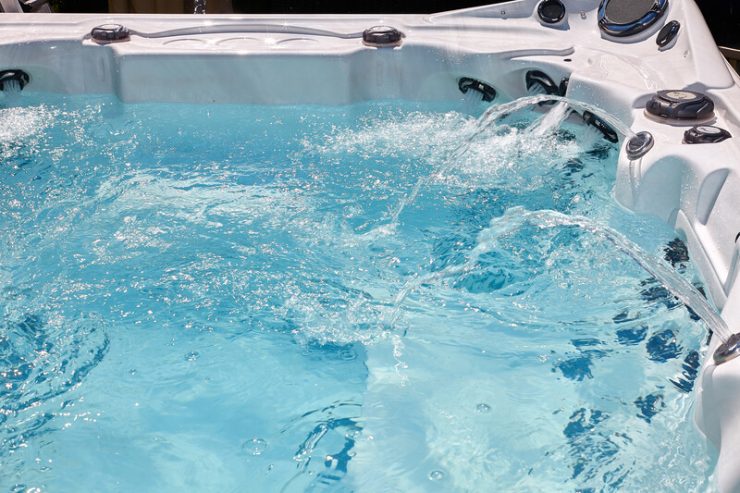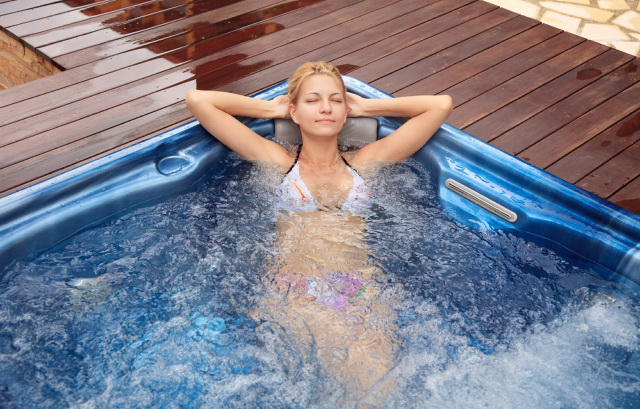Shocking is crucial for crystal-clear water in your hot tub. But is it possible to over shock your hot tub?
It is possible to over shock your hot tub, and many experienced owners accidentally do it. Overstocking throws the water chemistry balance off and can damage seals and components. However, you’re unlikely to damage your hot tub, unless you over shock your spa regularly.
The occasional over-shock isn’t the end of the world, but constantly adding too much shock can have knock-on effects. So, let’s look at the downfall of over-shocking your hot tub.

Article Contents
What Happens if You Add Too Much Shock?
Adding too much shock to your hot tub will still achieve the desired effect – dead algae and it will clear up the water. But, you will also throw off the chemical balance of the water.
The pH will either go up or down depending on the shock you use. Chlorine shock adds chlorine to the spa and significantly impacts the alkalinity and pH. Even though non-chlorine shock doesn’t contain chlorine, it can still affect the pH and alkalinity to a lesser degree.
If you add too much shock to your hot tub, you’ll need additional chemicals such as pH Up and pH Down to fix the balance. Aside from this, too much shock (particularly chlorine shock) can negatively affect you and your belongings.
Is it Safe to Swim in an Overshocked Spa?
The chlorine level of your hot tub needs to be within the safe range of 1-5 ppm. Outside this range, the tub isn’t safe for swimming.
If you swim in a highly chlorinated tub, the water can:
- Irritate your skin and eyes
- Bleach your swimwear and weaken the fabric
- Cause jewelry to turn green
- Cause bleached hair to turn green
Before swimming in your hot tub, you must wait until the chlorine and pH levels are within normal ranges.
Is Too Much Shock Bad for Hot Tub Equipment or Walls?
Unless you do it regularly and the chlorine levels remain elevated for an extended time, adding too much shock to your hot tub won’t negatively affect the tub and its components.
The damage that over-shocking can do will depend on the existing water chemistry and shock type.
The most common shocks are sodium dichlor/trichlor, calcium hypochlorite, and non-chlorine shock.
Sodium Dichlor/Trichlor
Sodium dichlor is one of the best and most common chlorine shocks to use in your hot tub, regardless of whether it’s a chlorine or bromine spa. Sodium trichlor can be used in a pinch but isn’t recommended as it is very acidic.
Dichlor has about a 55% chlorine concentration and already contains cyanuric acid (CYA) as a stabilizer. The cyanuric acid reduces chlorine from burning off in the sunlight. But having too high a level in your pool can be dangerous.
The ideal range for CYA is between 30-50 ppm. If the level is too low, the chlorine will burn off too quickly, and the shock won’t be effective. On the other hand, the acid can damage the spa filter and walls if the level is too high, particularly if the hot tub is vinyl.
And chlorine becomes far less effective when CYA levels are too high.
If your hot tub’s CYA level is too high, check out our guide here on how to lower it: Hot Tub Cyanuric Acid (Stabilizer) High | How to Lower
Calcium Hypochlorite
This shock has a much higher chlorine concentration (>70%) but doesn’t contain cyanuric acid so it will burn off quickly under direct sunlight. This is why it’s not the ideal chlorine shock.
Calcium hypochlorite, also known as cal hypo, contains a lot of calcium. Adding too much to your hot tub can create deposits that can clog piping and the filter. Again, it’s best to avoid cal-hypo as a shock unless your calcium hardness is already low.
The ideal range for calcium hardness is 150-250 ppm. So, once you notice it’s outside the ideal range, balance it as soon as possible to prevent lasting damage to the tub housing and inner mechanics.
Non-Chlorine Shock
Because it doesn’t contain chlorine, this shock doesn’t act as a disinfectant but does act as an oxidizer. As a result, it helps break up total chlorine into free chlorine, improving chlorine sanitation.
Non-chlorine shock, such as potassium monopersulfate (MPS), is suitable for bromine hot tubs and chlorine. However, MPS frees used bromine ions and increases bromine concentration in the water. This high bromine level has a similarly damaging effect as chlorine, corroding pipes, the filter, and even the heater.
If the bromine level of your hot tub is too high, check out our guide on how to lower bromine levels asap: Bromine in Hot Tub High | How to Lower Bromine Levels
Why is Hot Tub Cloudy After Adding Too Much Shock?
After shocking, it’s normal for the water to be cloudy, regardless of whether you added too much shock. Several reasons for post-shock cloudy water include filtration, chemical imbalance, and water hardness.
Finding out the root cause of the cloudy water is a simple process and an equally simple fix.
Poor Filtration
After shocking your spa, you might think the job is done. However, now the water is full of dead algae and contaminants (the particles giving the water a cloudy appearance) that need flushing out.
A simple fix is to keep the hot tub filtering continuously for the day. And clean the filter to clear trapped debris. If you’ve just dealt with a large algae outbreak, clean the filter several times.
You can also use a spa clarifier (like the one below) to help clear the cloudy water quicker.
This clarifier is easy to use, doesn’t affect pH concentration, and has an Amazon rating of 4.7 stars. It might be tempting to use a pool water clarifier, but it’s important to use hot tubs specifically made ones as you’re dealing with higher temperatures and a higher bather load.
Chemical Imbalance
The most common chemical culprits for a cloudy hot tub after shocking are the pH and calcium hardness levels. This is why it’s essential to test the water chemistry before adding the shock.
The shock treatment won’t be as effective if the spa’s pH is above 8 and, therefore, too basic. Make sure to balance the pH level within 7-7.4 by using pH down agents and filtering the hot tub.
If your hot tub’s calcium hardness is high and you use cal hypo shock, this will increase the calcium concentration. Calcium tends to dissolve but if the saturation limit of the water has been reached, the calcium will precipitate out of the water.
The best way to fix this is to partially drain and refill your hot tub. Then use a non-calcium-containing shock to clear the cloudy water.
How Long Should I Wait Before Shocking the Hot Tub Again?
The general advice is to wait at least 24 hours before shocking your hot tub again. This will give the filtration system enough time to circulate and rid the water of dead algae.
Experts recommend shocking a hot tub once a week, at most. However, this will depend on the spa usage. If you shock it after every use, you’ll run the risk of over-shocking it and having to deal with normalizing chemical levels.
How Long Should You Wait to Swim After Adding Too Much Shock?
The best practice is to wait until the chlorine concentration is below 5 ppm and pH levels are 7.4-7.6 before swimming in your hot tub. A rough guide is to wait at least 24 hours after using chlorine shock. And to wait at least 20 minutes after using a non-chlorine shock.
How much time you’ll need to wait after using a chlorine shock will depend on how much shock you added, the stabilizer level, sunlight exposure, and how dirty the hot tub was.
Too much chlorine in the spa water will irritate the swimmer’s skin, eyes, and hair. Use a spa test strip to ensure the spa is safe.
Because non-chlorine shock freshens the water through a different process, most product manufacturers say you can safely use the hot tub after 20 minutes.

Final Thoughts
It’s understandable to think shocking a hot tub is like shocking a pool. However, it’s important to realize the differences. Hot tubs need more shocking because of their size, higher bather load, and higher temperatures.
So, it’s easy to see how any hot tub owner can over shock their hot tub. But, even so, it’s crucial to fix an over-shocked spa as it can have lasting damage to the tub housing and piping.




